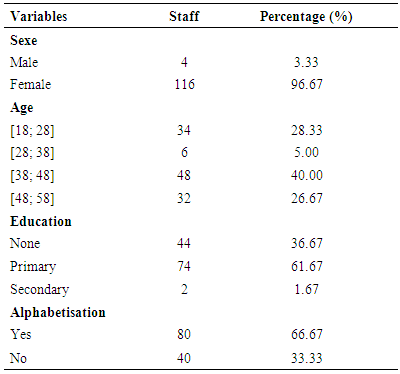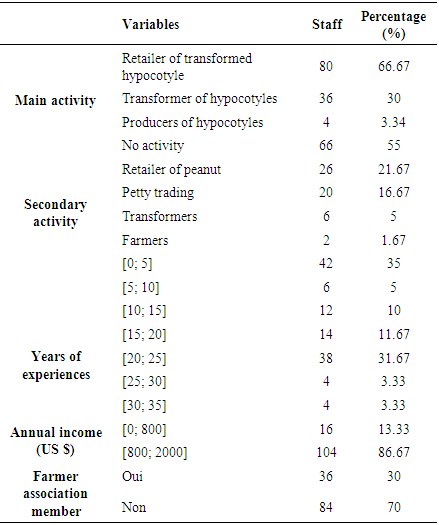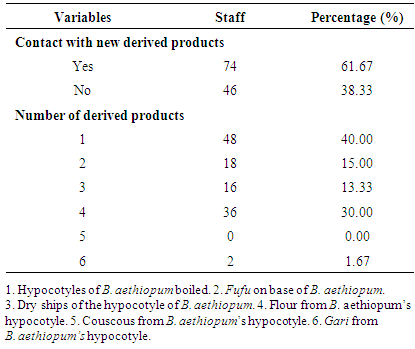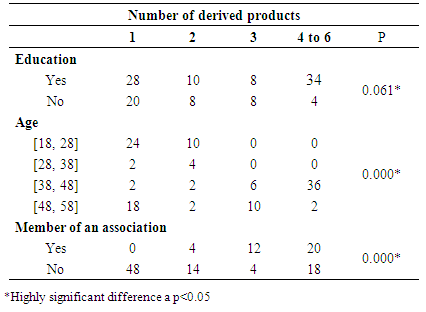-
Paper Information
- Next Paper
- Paper Submission
-
Journal Information
- About This Journal
- Editorial Board
- Current Issue
- Archive
- Author Guidelines
- Contact Us
Food and Public Health
p-ISSN: 2162-9412 e-ISSN: 2162-8440
2018; 8(2): 35-41
doi:10.5923/j.fph.20180802.01

Technological Processes Itinerary and Socio-economic Impact Assessment of Borassus aethiopum Hypocotyles “Agonté” Produced in Centre of Benin Republic
Brice M. Ohin1, Kifouli Adeoti1, Pacôme A. Noumavo1, 2, Sonangnon H. S. Kouhounde1, Kamal Garba1, Noel S. Tovide1, Sabine Ogoua1, Lamine Baba-Moussa2, Fatiou Toukourou1, Farid Baba-Moussa1
1Laboratoire de Microbiologie et des Technologies Alimentaires, Faculté des Sciences et Techniques, Université d’Abomey-Calavi, Cotonou, Bénin
2Laboratoire de Biologie et de Typage Moléculaire en Microbiologie, Faculté des Sciences et Techniques, Université d’Abomey-Calavi, Cotonou, Bénin
Correspondence to: Farid Baba-Moussa, Laboratoire de Microbiologie et des Technologies Alimentaires, Faculté des Sciences et Techniques, Université d’Abomey-Calavi, Cotonou, Bénin.
| Email: |  |
Copyright © 2018 Scientific & Academic Publishing. All Rights Reserved.
This work is licensed under the Creative Commons Attribution International License (CC BY).
http://creativecommons.org/licenses/by/4.0/

Since a few years, Borassus aethiopum hypocotyle, called Agonté in Benin, is more and more produced, processed, marketed and consumed in the large urban centers of Benin. However, its diverse modes of consumption are not documented and thus are little known. In this context, this study was performed to investigate the derived products from the transformation of Agonté. Face-to-face interviews of 120 producers, sellers and transformers were conducted. The majority of those interviewed (96.67%) are women. The investigations concerned the production mode, the distribution channel, the consumption mode and the transformation processes of the hypocotyle. Data were analyzed using means, percentage, frequencies and Fischer’s test. The results show that Agonté is used as well in feeding as for therapeutic uses. The most wide-spread mode of consumption is the boiled shape. Besides this shape of consumption, Agonté is also transformed in a craft way into flour, couscous, dry ships, fufu, and gari. Half of the investigated people have an annual income ranged between 800 and 2000 $ US. Due to its importance, Agonté deserves a particular attention for a better processes assessment of derived products.
Keywords: Borassus aethiopum, Agonté, Derived products, Underutilized species, Local products valorization
Cite this paper: Brice M. Ohin, Kifouli Adeoti, Pacôme A. Noumavo, Sonangnon H. S. Kouhounde, Kamal Garba, Noel S. Tovide, Sabine Ogoua, Lamine Baba-Moussa, Fatiou Toukourou, Farid Baba-Moussa, Technological Processes Itinerary and Socio-economic Impact Assessment of Borassus aethiopum Hypocotyles “Agonté” Produced in Centre of Benin Republic, Food and Public Health, Vol. 8 No. 2, 2018, pp. 35-41. doi: 10.5923/j.fph.20180802.01.
Article Outline
1. Introduction
- Plant genetic resources contribute highly to food security over the world. Among these non-timber forest products (NTFP) play an important role. Non-timber forest products are wild plants species found in the forest and contribute substantially to the diet of population [1]. Indeed, NTFP are used for food, medicinal purpose and contribute to household income [2, 3]. It is therefore appear clearly that NTFP can also contribute to the reduction of poverty and malnutrition. Most of local populations in Africa and particularly in Benin are extremely dependent on forest products. These forest products deserve a particular attention with the aim of a better valuation and open big perspectives of the reduction of the poverty while strengthening the food safety.Numerous authors were interested in the evaluation of the contribution of the food forest resources to the economy of the households [4-6]. Borassus aethiopum a non-timber forest product, is a palm tree of african origin, belonging to the Palmae family. Many studies about the analysis of the fresh pulps fruits [7], nutritional and and antinutritional profil of shoots [8], the stock and socio-economic uses [9] and profitability assessment [10] were conducted in several countries of Africa.It’s a multipurpose palm tree. Each part of the fruit can answer sociocultural, economic and environmental needs for the people [11]. B. aethiopum provides both food and non-food values to the local communities. Its fruits, endosperms and hypocotyles are edible. In Benin, commercialization of hypocotyle remain the most important way to consume B. aethiopum. Hypocotyle is the root obtained from fruit after 6 months germination. It is boiled before eating. This product is highly appreciated and consumed by population and is sold in most of the important cities among these Cotonou’ city rank the first. Hypocotyl is sold by hawker in the plastic bag without respect of hygiene rules.The consumers lend them aphrodisiac properties, which properties have been highlighted in some studies [9, 12]. The hypocotyles of B. aethiopum are very rich in available carbohydrates (81.00±0.23 g/100gg dry weight), crude lipids (0.010±0.00 g/100 g dry weight) and crude proteins (6.90±0.14 g/100 g dry weight) [8]. The calorific value of the B. aethiopum shoots is 350 kcal/100 g which is lower than 365.71 kcal/100 g reported in the shoot from Yobe State [13]. The energy value is within the range of recommended daily intake of 300 kcal of energy per 65 kg body weight adult human [14]. The shoots therefore if consumed in good quantity could be a good source of energy.The potential socioeconomic assets of germinated shoot were not enough studied. Indeed, there is not much documentation on the storage techniques, preservation, using, marketing and the technical routes of obtaining hypocotyles and the derived products.This study aimed to determine the technical itinerary of production boiled hypocotyle, derived products and assess the socio-economic impact of these products on producers’ daily live in Republic of Benin.
2. Material and Methods
2.1. Study Area
- This study was conducted in Savè city located in the center of Benin (Figure 1). The villages and markets of three districts (Sakin, Plateau and Okpara) of Savè were investigated. Were randomly included in this survey sellers, retailers and producers of B. aethiopum’s hypocotyles.
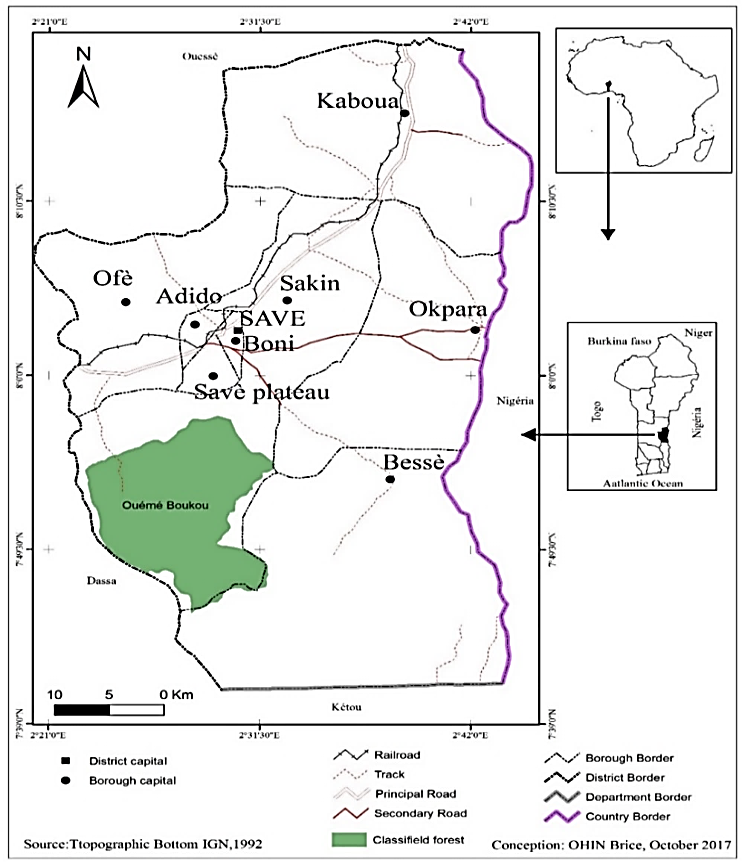 | Figure 1. Representation of area of study |
2.2. Survey
- This survey was done to obtain information concerning the socioeconomic characteristics of the actors from B. aethiopum’s hypocotyle processing sector. The socioeconomic characterization concerned the following parameters: age, sex, academic level, marital status, main activity, number of years of experiment in the processing of the derived products, membership in a processing organization and ethnic group. Several over informations relative to the derived products of B. aethiopum’s hypocotyle, sociocultural knowledge of these derived products and various operations allowing to obtain these products was collected. A questionnaire was designed to facilitate the collection of the quoted information higher. One hundred twenty (120) sellers and producers were interviewed. They were selected using the Snowball sampling method.
2.3. Data Processing Analysis
- Collected data was checked and then entered into the computer for final analysis. Microsoft Excel (2013) and the Social Statistical Package for Science (SPSS) software Version 21 were used to perfom the analysis and the threshold of 5% was retained for the significant differences. The data were analyzed using the means, frequencies, averages, percentages. Likewise the relationship between the parameters were examined with bivariate analysis (Fischer’s exact test: T-test).
3. Results
3.1. Socio-Demographic Profile of Respondents
- The table 1. shows the distribution of the respondents according to the sociodemographic characteristics, worth namely the sex, the age and the academic level. Almost all of the investigated people belong to the Tchabè ethnic group. It emerges from this table that the activities bound to the sale and to the processing of B. aethiopum hypocotyles are essentially devolved to the women. Indeed, the majority of the investigated population is female. They represent 96.67% of the sample. About 61.67% of investigated people received at least a primary education even if the program was not completely finished.About 40% of investigated people appeared in 38-48 years old. The transformers of this age bracket are often women who transform Agonté. However, the sale is mostly made by younger women of the age bracket of 18-28 years (Often girls close to producers). They represent 28.33% of the investigated people.
|
3.2. Economic Profile of Respondents
- The production, processing or sale of B. aethiopum germinated shoot are a main or secondary activity for the actors of this speculation. It is necessary to note that the transformation takes into account the simple cooking of Agonté serving as snack but also the transformation processes of the Agonté in derived products revealed in the present work. Approximately 66.67% of the investigated people have for generative main activity of income the sale of the transformed Agonté (Table 2). About 30% of the respondents are involved in the transformation of processes while only 3.34% produces it. Secondary activities are covered by 45% of the investigated population. Listed activities concerned the trade of agricultural products and manufactured and the family agriculture. So, 21.67% of the people having a secondary activity devote to the sale of the peanut against 16.67% which sell diverse products. About 5% are involved in the processes of transformation of hypocotyles in derived products. A tiny part, takes care of rural works (1.67%). The activities were bound to the production, the sale and the transformation of the Agonté is a long-lasting activity for the involved populations. About 31.67% make this activity for at least 20 years. These activities are obviously generative of income for these populations. According to the frequencies of sales, the actors of this activity make going annual receipts 2000$ US. The majority of the respondents (86.67%) make a recipe between 800 and 2000 $ US. However, the actors of production, sale and transformation of the Agonté of our study area are not unfortunately organized in group for a good management of this activity or for a better productivity (70% of the investigated are not a part of association or rustic group).
|
3.3. Some Derived Products of B. aethiopum Hypocotyles
- The main derived product of B. aethiopum hypocotyles is the boiled hypocotyle collectively called agonté or agbonté in Benin. The table 3 presents the different derived products of B. aethiopum and their knowledges according to the investigated populations. The number of these derived products is six (6). Outside the main product (boiled hypocotyles), the majority of the respondents (61.67%) recognizes to know at least another derived product against 38.33% which knows only the main product. 40% of the respondents were known at least a by-product of hypocotyles. In definitive, six (6) derived products of B. aethiopum hypocotyle were check off (boiled hypocotyle, flour, gari, fufu, dry chips and couscous. The figure 2 shows the technological processes of the different derived products.
|
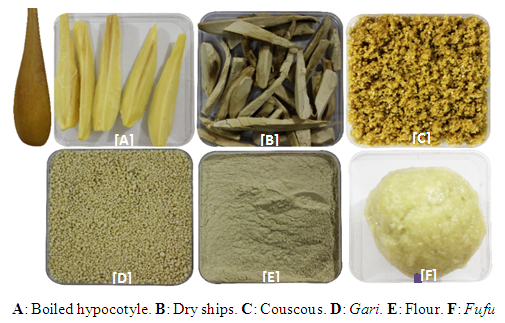 | Figure 2. Some derived products of B. aethiopum |
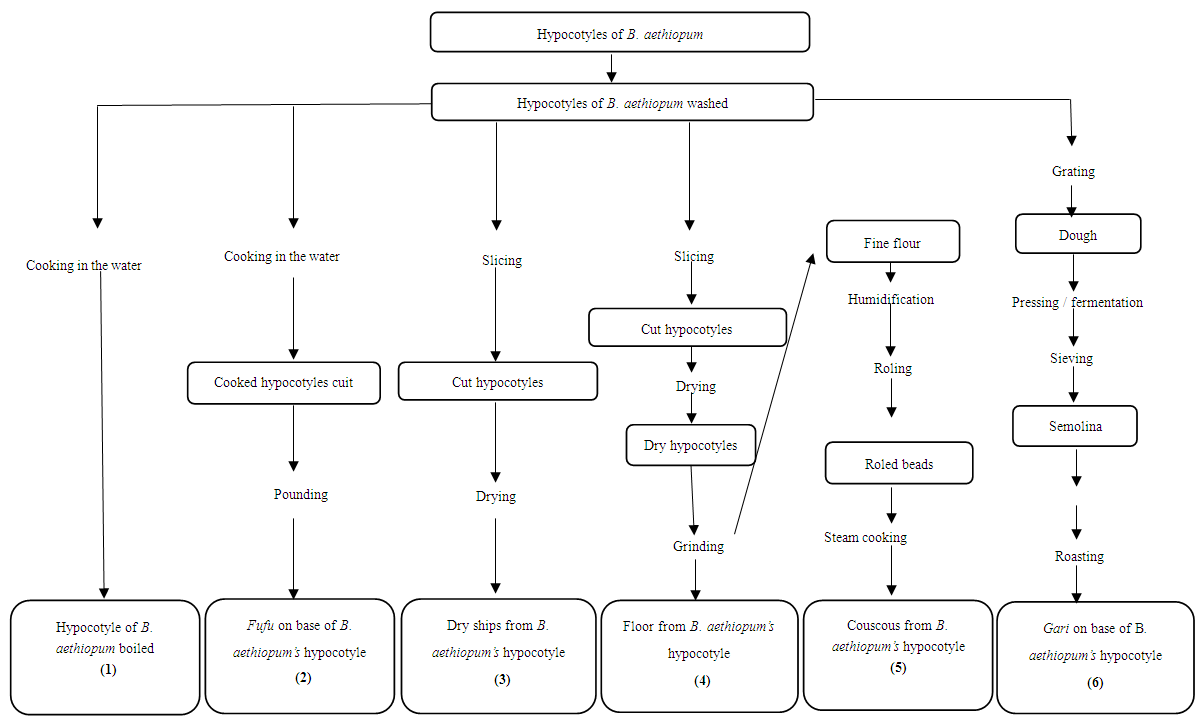 | Figure 3. Technological diagram of the B. aethiopum derived products |
3.4. Influence of the Production Frequency of Derived Products of B. aethiopum Hypocotyles Counted on the Average Annual Income
- The average annual income of the respondents varies according to the production frequency per a week. The frequency of weekly production varies between 1 and 7. Half of the investigated people has a frequency of production of seven times a week, what allows them to be ranged between 800 and 2000$ US a year. Only 5% of the investigated people produce once a week. This influences considerably their average annual income esteemed around 400$ US. There is a significant difference at the threshold of 5% between the frequency of production and the annual average income (P=0.001).
|
3.5. Impact of the Academic Level, Age and Membership in a Grouping on the Knowledge of Derived Products of B. aethiopum Hypocotyle
- The results of inquiries revealed that the knowledge of the derived products is a function of two factors: the age and the membership in a farmer group. The academic level of the interviewed people has no influence on the number of derived products stemming from B. aethiopum germinated shoot known by the investigated (p=0.061). Indeed, at least 16.66% of the people know besides the main derived product (boiled B. aethiopum hypocotyles) at least another product stemming from the processing of the B. aethiopum germinated shoot). Of other one, the knowledge of derived products of B. aethiopum’s hypocotyle varies according to age. All the investigated people whatever is their age know the boiled B. aethiopum hypocotyle. Nevertheless, only the respondents belong of the age bracket [38, 48] and [48, 58] know at least three derived products. The ANOVA test made on the age and the knowledge of by-products gives a no probability. Thus, there is a significant difference at level p = 0.05 between the age and the knowledge of derived products stemming from the B. aethiopum hypocotyle. Finally, it is necessary to note that only 30% of the respondents belongs to an association or a grouping of people. On the other hand, 55.55% of investigated people belong to an association recognize to know at least 4 to 6 derived products. The ANOVA test made on the membership in a farmer group and the knowledge of derived products gives a no probability. Hence there is a significant difference at level p = 0.05 between the membership in a grouping and the knowledge of derived products stemming from B. aethiopum hypocotyle.
|
4. Discussion
- The production, the technological process and the sale of the derived products of the "Agonté" (B. aethiopum hypocotyle) is a feminine activity (Table 1). The collection of fruits of palm in swamps and other inaccessible zones, where the fruits are plentiful, was a precarious activity for women. Women's strong percentage in this activity is due by the fact that she does not require a lot of physical effort. This allows female farmers to have an income independently of that of the spouse. This activity thus allowed enough women to have a financial autonomy and managing certain vital needs of their children (health, food and instruction). These results also reported to show that the marketing of the not ligneous forest products is very prosperous and allows to complete household incomes in western Africa [15]. It is clear that the transformation of B. aethiopum hypocotyles is the women business and adult activity. The girls play only a role of selling of products, thus their sale on markets. These results confirm those of a study which show the crucial role of the women in the production of roots and tubers, so seeing their income improving and reducing of the blow the disparity between men and women within the african agricultural systems [16].The most of the women who lead this activity belongs to Tchabè ethnic group. It is the majority ethnic group of the natural growth area of the B. aethiopum species. The majority of the investigated people received at least a primary education. This makes them easy the exchanges, communication and management of their financial income. About 66.66% of the investigated population lead as main activity the sale of boiled hypocotyles against the third which is interested in the transformation of its derived products. These results show that it is the boiled form which are the best appreciated in the activities of sales. The study reveals that 45% of the actors of B. aethiopum hypocotyle sector exercise a second generative activity of income to increase their sources of income.The majority of the investigated people make an annual income between 800 and 2000 US Dollars (Table 4). This activity could then feed those who exercise it, if they did not have other additional family responsabilities. This result is similar to those from others studies, in particular that of which showed that edible hypocotyles were more profitable and efficient than others parts of the tree [10]. In addition, we could point out the fact that more than half actors are not a member of farmers group or development association, which indicates a wrong organization of the sector (Table 2). Note that the technological mastery processes of transformation and sale of B. aethiopum derived products acquires whit experience. This study allowed us to determinate the socioeconomic potential and the technological processes of the B. aethiopum hypocotyles and its derived products. The production and the sale of derived products of B. aethiopum hypocotyle in Savè are generative activities of income for the populations who are interested in it. Savè district establishes a reference point regarding production and marketing of Agonté in Bénin [17]. The production of Agonté is a devolved activity most of the time to the men. It is an activity which requires many physical efforts, in particular for the stages of collections and transport of fruits and preparation of the sowing. The sale and the transformation of Agonté and derived products is on the other hand a feminine activity. Several authors showed the economic role of the user communities of the Agonté. These authors due to their works described and clarified the economic importance of the use of all or part of B. aethiopum species for the use of populations [5, 17].
5. Conclusions
- This study was interested in the socioeconomic impact of production, transformation and sale of B. aethiopum hypocotyle. The aim was firstly to identify the technical transformation processes of products derived from the hypocotyle of B. aethiopum. Secondly, the socio-economic impact of these different by-products on the lives of the populations was evaluated. Six main derived products were registered. The various technical itinerary, leaving of these roots generate derived products the sale of which gets considerable profits for the developers. Finally, this study revealed that the boiled hypocotyle of B. aethiopum “Agonté” is the most consummate and most marketed of derived products of B. aethiopum. The boiled Agonté is vended in Benin as street food. This exposes it to microbial contamination. Thus, its microbiological quality control become necessary to preserve the consumers health from foodborne diseases.
ACKNOWLEDGEMENTS
- Our sincere acknowledgement to Professor Houinsou Dedewanou of the Faculty of Agronomic Sciences of the University of Abomey-Calavi for his invaluable assistance during the investigation phase of this work.
 Abstract
Abstract Reference
Reference Full-Text PDF
Full-Text PDF Full-text HTML
Full-text HTML